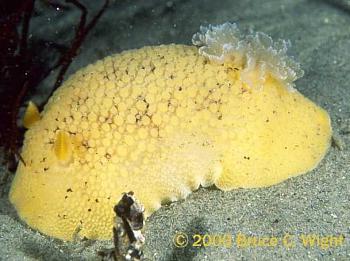

Peltodoris nobilis
(MacFarland, 1905)
Order: NUDIBRANCHIA
Suborder: DORIDINA
Superfamily: EUDORIDOIDEA
Family: Dorididae
DISTRIBUTION
West Coast of North America from Alaska to Baja California, Mexico.
PHOTO
Upper: on sand in about 25 feet of water at Point Lobos, Monterey, California. Lower: off San Miguel Island California. Photos: Bruce Wight.
Formerly known as Anisodoris nobilis, then Diaulula nobilis - see message #8419. Now placed in Peltodoris - see message #16240
Similar in shape and colour to Archidoris montereyensis there are a few external differences which can be used to identify them. In Peltodoris nobilis the gills are white-tipped and black or dark brown pigment, if present, does not occur on the tubercles. In Archidoris montereyensis the gills are the same yellow colour as the mantle and dark pigment often darkens some of the tubercles. See Bruce Wight's message comparing the two species.
"By the way, Anisodoris nobilis is the only one of these [sea-lemon] dorids with a distinct lemon scent. Its citrus fruit aroma is quite pleasant and usually only given off when the animal is handled." See Sandra Millen's message.
-
MacFarland, F.M. (1905). A preliminary account of the Dorididae of the Monterey Bay, California. Proceedings of the Biological Society of Washington, 18: 35-54
-
Valdés, A. & Gosliner, T. M. 2001. Systematics and phylogeny of the caryophyllidia-bearing dorids (Mollusca, Nudibranchia), with the description of a new genus and four new species from Indo-Pacific deep waters. Zoological Journal of the Linnean Society, 133: 103-198.
-
Valdés, A. 2002. A phylogenetic analysis and systematic revision of the cryptobranch dorids (Mollusca, Nudibranchia, Anthobranchia). Zoological Journal of the Linnean Society, 136: 535-636.
Rudman, W.B., 2000 (October 11) Peltodoris nobilis (MacFarland, 1905). [In] Sea Slug Forum. Australian Museum, Sydney. Available from http://www.seaslugforum.net/find/anisnobi
Related messages
Re: Peltodoris nobilis eggs (British Columbia)
August 17, 2007
From: Jackie Hildering & Glen Miller

Concerning message #20378:
My belief that the egg mass in the earlier message belonged to Peltodoris nobilis is based on having seen what is captured in these photos. Always risky I strongly realize, but I believe we have Peltodoris nobilis laying an egg mass of the same morphology?
Locality: Five Fathom Rock, Port Hardy, 40', British Columbia, Canada, Pacific Ocean, 19 November 2005, Rocky bottom. Length: + 18 cm . Photographer: Glen Miller.
Jackie Hildering
earthlingenterprises@telus.net
Hildering, J. & Miller, G., 2007 (Aug 17) Re: Peltodoris nobilis eggs (British Columbia). [Message in] Sea Slug Forum. Australian Museum, Sydney. Available from http://www.seaslugforum.net/find/20479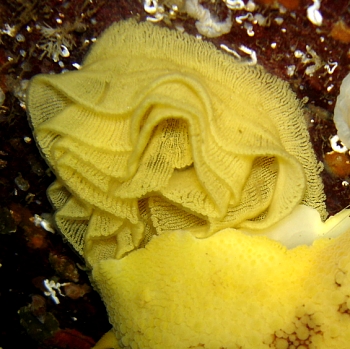
Thanks Jackie and Glen,
I like to have some visual evidence on the Forum, and this photo certainly supports your suggested identification. Since this identity question arose I note that we have a message from Jim Lyle [#18682] which has a photo confirming your identification. All in all a good result - if perhaps a little out of order.
Best wishes,
Bill Rudman
Peltodoris nobilis eggs (British Columbia)
August 14, 2007
From: Jackie Hildering
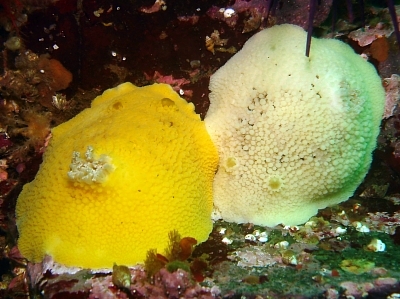
Hoping this is more of a contribution than a query. Here is another photo of Peltodoris nobilis mating and of their egg coil. If I indeed have the ID correct, thought it might be interesting to offer these photos to show what variation there can be in the spotting in this species. Thanks for all you do.
Locality: Warbonnet Wall, 60', British Columbia, Canada, Pacific Ocean, 29 July 2007, Wall. Length: 22 cm. Photo: Jackie Hildering
Jackie Hildering
earthlingenterprises@telus.net
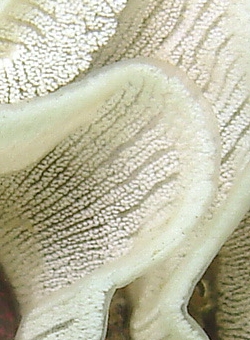
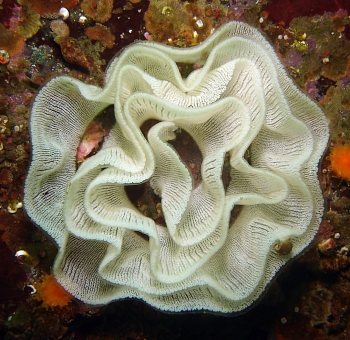
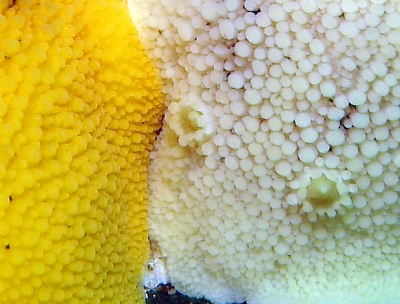
Hi Jackie,
Well these are certainly some great shots of Peltodoris nobilis, indeed showing the extremes in color variation. The egg shots are great also, in Bill's close-up, cropped shot you can really see the morphology and arrangement of the egg capsules and the strands that form the ribbon. My only question is why do you think these eggs belong to this species?
Thanks for sharing,
Dave Behrens
Peltodoris nobilis from California waters
August 9, 2007
From: Ken Tucker
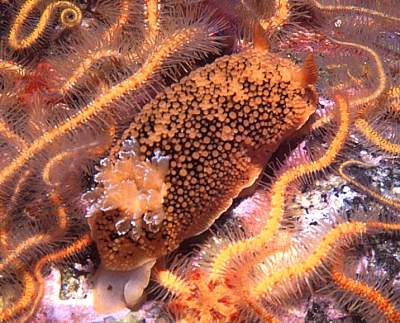
I've had this photo tagged as Dialula nobilis, from a match to a single photo, by Marli Wakeling. However, it's a name I cannot find in SSF, nor does any image from Eastern Pacific seem a proper match. It's also a name with a single match using Google, which seem suspicious.
Locality: Channel Islands, California, USA, Pacific Ocean, 30 Aug 1995. Photographer: Ken Tucker.
Can you ID?
Ken Tucker
ken@kilili.com
Tucker, K.C., 2007 (Aug 9) Peltodoris nobilis from California waters. [Message in] Sea Slug Forum. Australian Museum, Sydney. Available from http://www.seaslugforum.net/find/20395Dear Ken,
I don't think I need Dave to confirm this is a dark form of Peltodoris nobilis. As you will see on the Fact Sheet it was Anisodoris nobilis, then Diaulula nobilis. A search on the Forum under any of those three names should have found it because all three names are on the Fact Sheet. If you searched for Dialula nobilis it would have been more of a problem but I got a few pages of results for the mispelling Dialula nobilis in Google. Databases are a great help, but they are not that good if you have a mispelling - and I am never sure if the u in Diaulula comes before or after the a.
Despite all that, it is nice to get such a dark specimen to complete the colour range of this species on the Forum - all supposing I've got the ID correct.
Best wishes,
Bill Rudman
Peltodoris nobilis mating
December 4, 2006
From: Jim Lyle
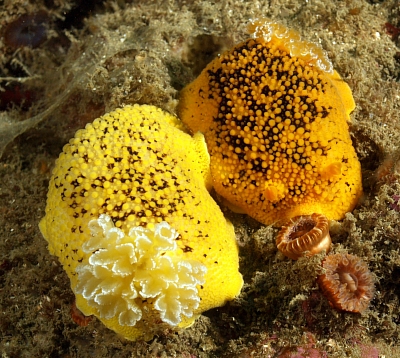
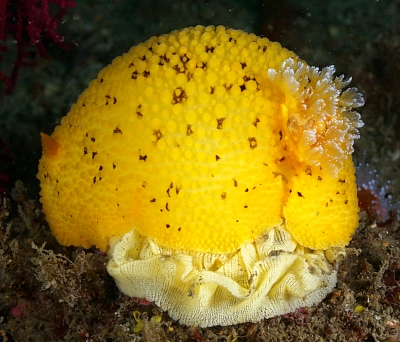
Dear Dr. Rudman,
Southern California is currently undergoing a population boom of Peltodoris nobilis (formerly Anisidoris nobilis ). This large, yellow nudibranch seems to be everywhere along with its bright yellow egg ribbons.
On a dive this past weekend, with camera in hand, I encountered two, different-colored individuals copulating, and another laying its eggs; attached are photographs for the forum.
Locality: Palos Verdes Peninsula, 25 metres, California, USA, Pacific Ocean, 25 November 2006, Rock reef. Length: 60 mm. Photographer: Jim Lyle.
Best,
Jim
jlyle@adelphia.net
Lyle, J.L., 2006 (Dec 4) Peltodoris nobilis mating. [Message in] Sea Slug Forum. Australian Museum, Sydney. Available from http://www.seaslugforum.net/find/18682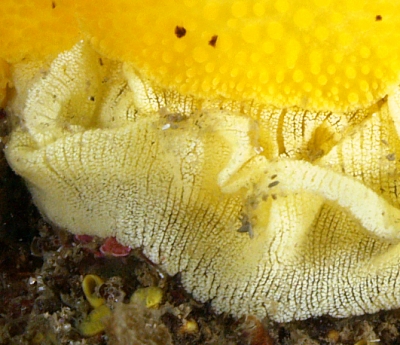
Thanks Jim,
I included a close-up to show the delicate folding of the egg string within the egg ribbon.
Best wishes,
Bill Rudman
Fish attacking Peltodoris nobilis
July 12, 2006
From: Leslie Harris
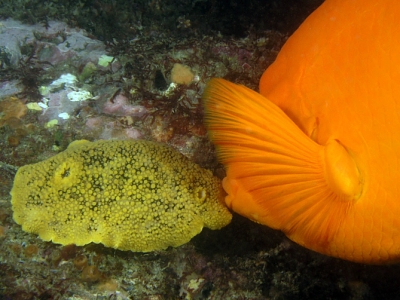
Dear Bill
As a follow up to my comment the other day about a fish picking on a nudibranch [message #17073] here are Kevin Lee's pictures of the attack and the victim 5 minutes afterwards. The aggressor is a California Garibaldi Hypsypops rubicundus and its intended snack item is Peltodoris nobilis. The fish was targeting the nudibranch's rhinophores & gill filaments.
Locality: Deadman's Reef, off Laguna Beach, about 60 feet, California, USA, Northeast Pacific, 4 July 2006, temperate rock reef. Length: 3 inches. Photographer: Kevin Lee.
Cheers,
Leslie
lharris@nhm.org
Harris, L.H., 2006 (Jul 12) Fish attacking Peltodoris nobilis. [Message in] Sea Slug Forum. Australian Museum, Sydney. Available from http://www.seaslugforum.net/find/17102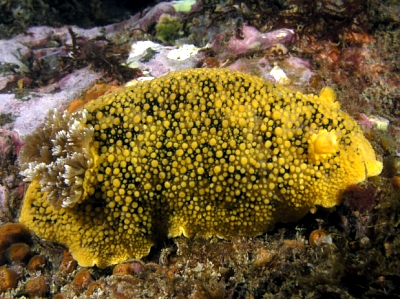
Thanks Leslie (and Kevin),
Actually catching fish nibbling at nudibranchs 'in natural situations' is quite difficult. When we think of the defensive metabolites [chemicals] many nudibranchs have in their skins we tend to forget they are often found in the gills and rhinophores as well. If you look carefully at living animals you can often find opaque white lumps scattered through the transparent or semi-transparent gills. These are aggregations of defensive chemicals which we hypothesise are designed to serve in precisely this sort of situation. A curious and hungry fish will nibble the gills or rhinophores and be deterred from investigating the rest of the body by the distasteful chemicals it experiences. One large group of dorid nudibranchs, which used to be called the Cryptobranchia [= hidden gills] can protect their gills and rhinophores by withdrawing them into pockets beneath the skin.
Best wishes,
Bill Rudman
Peltodoris nobilis from Puget Sound, Washington
April 28, 2006
From: Jan Kocian
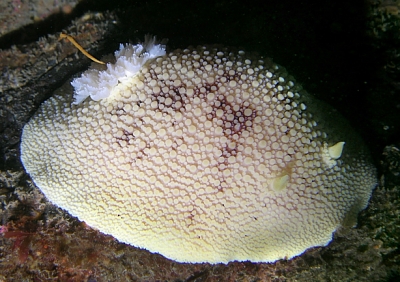
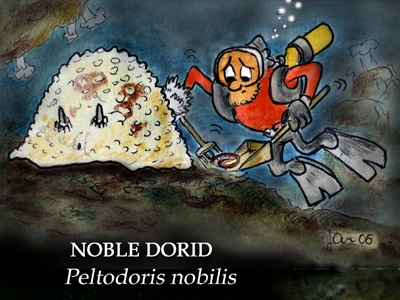
When looking for slugs, most of the time I find them eating, this was the first time I found one in the act which is part of the whole process associated with eating. Don't know how to put it delicately, so I include a cartoon..
Locality: Whidbey Island, Puget Sound, 15 feet, Washington USA, Puget Sound,NE Pacific Ocean, 26 March 2006, Rock Jetty. Length: 35mm. Photographer: Jan Kocian.
Jan Kocian
honkoc@hotmail.com
Kocian J., 2006 (Apr 28) Peltodoris nobilis from Puget Sound, Washington. [Message in] Sea Slug Forum. Australian Museum, Sydney. Available from http://www.seaslugforum.net/find/16210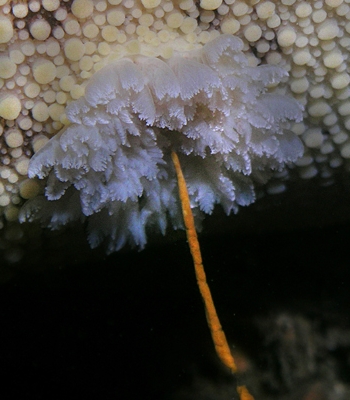
Hi Jan,
Well leave it to Bill to assign me the subject of Branch Sanitation. Yes Jan, what you have documented here is the process of faecal discharge. In Peltodoris nobilis, as you show here, the discharge of faecal material forms a long string. Other species defecate pellets.
Interestingly, examination of the feces can provide information about what the species is feeding on. The faeces of sponge eaters like P. nobilis will contain sponge spicules. Faeces of Marionia and Tritonia will contain the sclerites of the soft corals they feed on, and te feces of species like Navanax will contain the shells and radula of their prey.
We should note that your specimen here represents the white color variation of P. nobilis, which seems to becoming more common along this coastline. Maybe you can send us your shot with the white and yellow animals juxtaposed.
Thanks,
Dave Behrens
Re: Anisodoris nobilis - Peltodoris or Archidoris?
April 4, 2006
From: Angel Valdes
Concerning message #16234:
Dear Bill,
In our revision of the caryophyllidia-bearing dorids, Terry Gosliner and I found that the type species of Anisodoris and Diaulula belong to the same genus, and therefore these two names are synonyms, Diaulula having precedence. We also found that all caryophyllidia-bearing dorids are members of the same clade, thus, if we are correct, the presence of caryophyllidia is an important character for dorid classification.
The problem with species of Anisodoris is that this genus name has been widely used for species with and without caryophyllidia. It would be a very time consuming task to review all species of cryptobranch dorids and try to determine their taxonomic placement in light of the results of our phylogenetic hypothesis. So we preferred to provide diagnoses for all genera and leave for future research, or our colleagues research, to determine the taxonomic placement for all those hundreds of species names. When we wrote the diagnoses we were conscious that many of them where too inclusive or exclusive and would need further work after examining real animals.
Said so, "Anisodoris" nobilis lacks caryophyllidia, has a prostate with two distinctive regions, the anterior border of the foot is grooved and notched, and it has no jaws on the labial cuticle, therefore, and according to my subsequent paper (Valdés 2002), it should be placed in the genus Peltodoris.
I think the Forum is an ideal place for fine tuning and testing of proposed classifications, by examining and posting anatomical features of species that are overlooked in more general phylogenetic hypotheses and revisions of larger groups.
-
Valdés, A. & Gosliner, T. M. 2001. Systematics and phylogeny of the caryophyllidia-bearing dorids (Mollusca, Nudibranchia), with the description of a new genus and four new species from Indo-Pacific deep waters. Zoological Journal of the Linnean Society, 133: 103-198.
-
Valdés, A. 2002. A phylogenetic analysis and systematic revision of the cryptobranch dorids (Mollusca, Nudibranchia, Anthobranchia). Zoological Journal of the Linnean Society, 136: 535-636.
Best regards,
Angel
avaldes@nhm.org
Valdes, A., 2006 (Apr 4) Re: Anisodoris nobilis - Peltodoris or Archidoris?. [Message in] Sea Slug Forum. Australian Museum, Sydney. Available from http://www.seaslugforum.net/find/16240Thanks Angel,
Bill Rudman
Anisodoris nobilis - Peltodoris or Archidoris?
April 3, 2006
From: Bill Rudman
Concerning message #16105:
Dave,
I know you weren't taking a shot at me when you congratulated Kevin on keeping up with name changes while the Forum still has this species languishing under Anisodoris but I think we are (or at least I feel I am) in a difficult position here. In Valdes & Gosliner (2001) they synonymise Anisodoris with Diaulula but say that 'most of the species previously assigned to Anisodoris probably belong to the genera Peltodoris Bergh 1880 or Archidoris Bergh, 1878'.
But as this was a higher level revision they give no indication on where each species should go. So do I leave Anisodoris nobilis as is at present or flip a coin and place it in Peltodoris or Archidoris - which is now Doris anyway?
In less technological times, taxonomic revisions, like good wine, were left awhile to be considered, sipped and tasted, sometimes accepted, sometimes rejected, but the vital thing was there was time to consider them. Nowadays I sometimes think we are in a race to keep up with the latest changes without any real effort to reflect or consider them.
Now I have said that, I would appreciate any help in placing this species in the right genus, if possible. It's quite possible that it's correct generic placement is common knowledge amongst Californian experts but since I haven't found a published comment anywhere I need some guidance.
Cheers
Bill Rudman
billr@seaslugforum.net
Rudman, W.B., 2006 (Apr 3) Anisodoris nobilis - Peltodoris or Archidoris?. [Message in] Sea Slug Forum. Australian Museum, Sydney. Available from http://www.seaslugforum.net/find/16234Peltodoris nobilis from Santa Cruz Is.
April 3, 2006
From: Kevin Lee
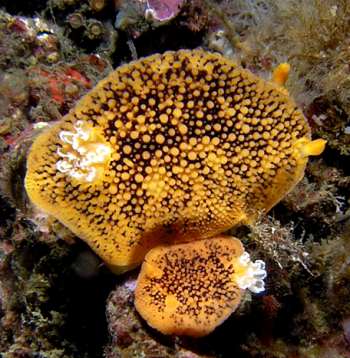
Here's a photo of 2 Peltodoris nobilis, large and small, side by side. Surely they are not mating?
Locality: Santa Cruz Island, approx. 35 feet, California, Eastern Pacific, 22 January 2006, Rocky substrate. Length: approx. 1.5 inches & 0.5 inch. Photographer: Kevin Lee.
K:-)
diverkevin@gmail.com
Lee, K., 2006 (Apr 3) Peltodoris nobilis from Santa Cruz Is.. [Message in] Sea Slug Forum. Australian Museum, Sydney. Available from http://www.seaslugforum.net/find/16105Dear Kevin,
I love it when folks are up to speed on recent nomenclatural changes. My compliments to you. I know how much of a pain it is to stay current, but sea slug systematics is being refined all the time, and we should expect continued revision.
The revision changing Anisodoris to Peltodoris occurred in Valdes & Gosliner (2001). I mentioned this revision in my Supplement II to Pacific Coast Nudibranchs.
Now, concerning whether this pair is mating, es they could be. It is not uncommon to find young adults pairing with large individuals. Whether or not reciprocal fertilization is accomplished will depend on the sexual maturity of the smaller individual. But 1/2 inch should be large/old enough.
References:
-
Behrens, D.W. 2004. Pacific Coast Nudibranchs, Supplement II - New species to the Pacific Coast and New information on the oldies. Proc. Calif. Academy of Sciences, 55(2): 11-54.
-
Valdes, A. & T.M. Gosliner. 2001. Systematics and phylogeny of the caryophyllidia-bearing dorids (Mollusca, Nudibranchia), with the description of a new genus and four new species from Indo-Pacific deep waters. Zool. Journ. Linnean Soc., 133: 103-198.
Best wishes,
Dave Behrens
Mating Anisodoris nobilis
October 1, 2001
From: Bruce Wight
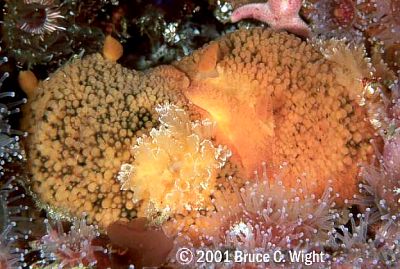
Hi guys,
Here are the pair of romantic Anisodoris nobilis I mentioned in my earlier message. I photographed them on my 4 day trip out to Santa Barbara Island, California last week, in about 40 feet of water at 7 1/2 fathoms reef.
Take care,
Bruce Wight
bwproductions@earthlink.net
Wight, B., 2001 (Oct 1) Mating Anisodoris nobilis. [Message in] Sea Slug Forum. Australian Museum, Sydney. Available from http://www.seaslugforum.net/find/5345Thanks Bruce,
Looks like the honeymoon suite with all the anemones tastefully arranged around them
Cheers,
Bill Rudman
Re: Anisodoris nobilis? from California
January 25, 2001
From: Bruce Wight
The photo looks like an Anisodoris nobilis to me. The key indicators I look for are the long yellow tubercles covering the body with the dark mottling, the yellow rhinophores, and the white branchial plume. Welcome to the world of these wonderful animals, Deb, keep your eyes peeled for we have a lot of great branchs in California.
Bruce
bwproductions@earthlink.net
Wight, B., 2001 (Jan 25) Re: Anisodoris nobilis? from California. [Message in] Sea Slug Forum. Australian Museum, Sydney. Available from http://www.seaslugforum.net/find/3614Thanks Bruce,
Bill Rudman
Anisodoris nobilis from Santa Cruz Island
January 25, 2001
From: Jeff Goddard
Hi Bill,
Deb Lantis' dorid from Santa Cruz Island looks like Anisodoris nobilis to me, albeit a dark-colored one. The large rounded dorsal tubercles, dark pigment between the tubercles, and the whitish gills are characteristic. The overall color of this species can vary considerably, depending on which sponges an individual has been grazing on (and for how long). I have seen quite a few specimens with bight red-orange ground color, although these have usually been smaller specimens. A. nobilis prefers yellow colored sponges like species of Mycale, but individuals will consume a wide variety of sponges, ranging in color from blue to red to yellow to tan. At Cape Arago, Oregon alone, I found A. nobilis preying on 19 different species of sponges.
Best wishes,
Jeff Goddard
goddard@lifesci.ucsb.edu
Goddard, J., 2001 (Jan 25) Anisodoris nobilis from Santa Cruz Island. [Message in] Sea Slug Forum. Australian Museum, Sydney. Available from http://www.seaslugforum.net/find/3615Thanks Jeff,
Bill Rudman
Anisodoris nobilis? from California
January 21, 2001
From: Deb Lantis
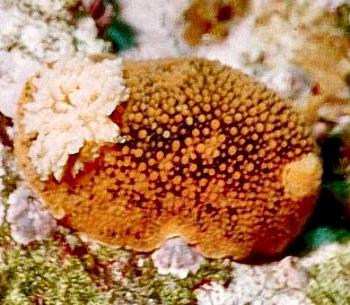
I have just recently become interested in nudibranchs. This photograph was taken off of Santa Cruz Island, California. I have been unable to identify it. Could you please help?
Thank you very much,
Deb Lantis
scubadu1@yahoo.com
Lantis, D., 2001 (Jan 21) Anisodoris nobilis? from California. [Message in] Sea Slug Forum. Australian Museum, Sydney. Available from http://www.seaslugforum.net/find/3514Dear Deb,
I think this is Anisodoris nobilis but I am a bit scared about trying to identify these yellowish dorids from California as my last foray into their identity was very confusing. The Californian 'team' are good at responding so hopefully in a day or so we shpuld have a definitve word on this animal for you.
Best wishes,
Bill Rudman
Another photo of Anisodoris nobilis
October 12, 2000
From: Bruce Wight

Dear Bill,
Here is another photo of Anisodoris nobilis to go with the one I used in my earlier message to compare this species with Archidoris montereyensis. This one was taken off San Miguel Island California.
Bruce Wight
bwproductions@earthlink.net
Wight, B., 2000 (Oct 12) Another photo of Anisodoris nobilis. [Message in] Sea Slug Forum. Australian Museum, Sydney. Available from http://www.seaslugforum.net/find/3162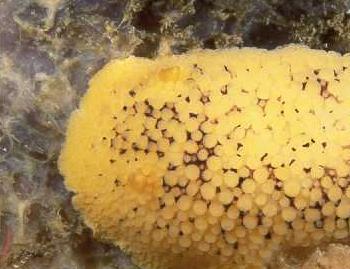
Dear Bruce,
Thanks again. Is the purplish sponge that this animal is crawling on one of its food sponges?
Best wishes,
Bill Rudman.
